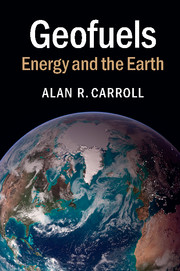Book contents
- Frontmatter
- Contents
- Acknowledgments
- 1 Introduction
- 2 The Living Earth
- 3 Warmed from Above: Solar Energy
- 4 Wind, Water, and Waves: Energy from the Fluid Earth
- 5 Covered in Green: Biofuels Basics
- 6 Fossil Farming: The Geologic Underpinnings of Biofuels
- 7 The Light of an Ancient Sun: Fossil Fuel Origins
- 8 Digging for Daylight: Coal and Oil Shale
- 9 Skimming the Cream: Conventional Oil and Gas
- 10 Stuck in the Mud: Fossil Fuels That Fail to Flow
- 11 Petrified Petroleum: Oil Sand and Gas Hydrate
- 12 Water, Water, Everywhere
- 13 Primordial Power: Geothermal and Nuclear
- 14 Out of Sight, Out of Mind: Geologic Waste Disposal
- 15 How Long Is Forever? Energy and Time
- 16 Conclusions
- Index
- References
3 - Warmed from Above: Solar Energy
Published online by Cambridge University Press: 05 March 2015
- Frontmatter
- Contents
- Acknowledgments
- 1 Introduction
- 2 The Living Earth
- 3 Warmed from Above: Solar Energy
- 4 Wind, Water, and Waves: Energy from the Fluid Earth
- 5 Covered in Green: Biofuels Basics
- 6 Fossil Farming: The Geologic Underpinnings of Biofuels
- 7 The Light of an Ancient Sun: Fossil Fuel Origins
- 8 Digging for Daylight: Coal and Oil Shale
- 9 Skimming the Cream: Conventional Oil and Gas
- 10 Stuck in the Mud: Fossil Fuels That Fail to Flow
- 11 Petrified Petroleum: Oil Sand and Gas Hydrate
- 12 Water, Water, Everywhere
- 13 Primordial Power: Geothermal and Nuclear
- 14 Out of Sight, Out of Mind: Geologic Waste Disposal
- 15 How Long Is Forever? Energy and Time
- 16 Conclusions
- Index
- References
Summary
At rest, however, in the middle of everything is the sun.
Nicolaus Copernicus, De revolutionibus orbium coelestium, 1543Our local star has continuously bathed the Earth in sunshine for the past four and a half billion years, interrupted only by the occasional solar eclipse. The Sun is expected to continue shining for billions of years to come, setting a gold standard of sustainability that no other major energy source can hope to match. The Sun supplies the energy for all plant life, and therefore is also the source of energy contained in both biofuels and fossil fuels. The Sun also powers the weather, through solar heating of the ocean and land surfaces. As will be discussed in the next chapter, hydroelectric and wind power are really just cleverly disguised versions of solar power. In fact, only two presently used energy sources can claim true independence from the Sun: nuclear fission and tidal energy. Nuclear fission relies on uranium, an element forged in the violent explosions of other, more massive stars called supernovae. Tidal energy results from the gravitational pull exerted on the ocean by the Moon, and to a lesser extent the Sun.
As powerful as it is, one thing the Sun cannot do on its own is to boil water at the ambient conditions found on the Earth's surface. At high noon on a clear day at the equator, sunlight heats the Earth's surface at a rate that is roughly equivalent to a portable electric hair dryer aimed at an average-sized desktop. The desktop (or ground surface) becomes warm, but not painfully so. At all other locations on the Earth the average rate of incoming solar power is less, because of clouds or to a Sun angle that is less than 90° relative to the horizon. Nowhere on Earth is it ever really hot enough to fry an egg on the sidewalk, a fact that can easily be demonstrated through independent study.
- Type
- Chapter
- Information
- GeofuelsEnergy and the Earth, pp. 32 - 56Publisher: Cambridge University PressPrint publication year: 2015
References
- 1
- Cited by



